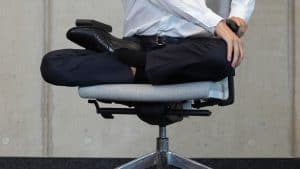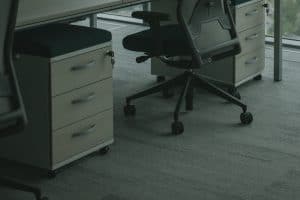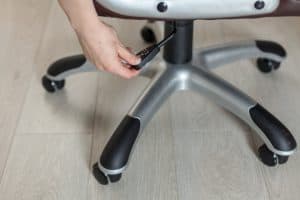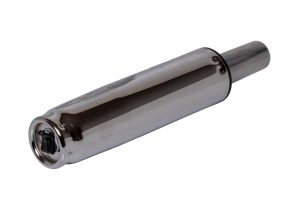According to reports, 2-3% of the American population suffers from Scoliosis. While the condition can be kept under control with medications and proper therapy, surgery is often kept as a last resort. Improper posture and sitting arrangement can either worsen the pain and contribute to erratic breathing problems regularly.
Management of Scoliosis doesn’t require a lot of things. All you need to do is find the right sitting position along with the best office chairs for scoliosis to keep the pain in control and reduce the risks of inflammation and worsening pain.
Consulting an orthopedic will suggest you about the right sitting posture and will time and time suggests you for sitting against the back of the chair instead of on the edge of the chair. Not just the posture and sitting posture, scoliosis patients also need to know about the various desk exercises to perform every few hours during your office hours.
Here, we will be discussing everything that you need to know about scoliosis and how to sit in a chair with scoliosis for optimal back support and relief.
Table of Contents
Best Ways to Sit with Scoliosis
Related Questions to Scoliosis
- Is Sitting or Standing Ideal for Scoliosis?
- Can You Have a Good Posture with Scoliosis?
- What Happens if You Do Nothing with Scoliosis?
- What Should I Avoid If I Have Scoliosis?
What is Scoliosis?
Scoliosis is a chronic medical condition that causes the spine to curve to one side, leaving it with either a C or S-shape, leaving the patient in constant discomfort. While the condition isn’t completely curable, patients need to sit on specialized chairs to improve their posture and spinal positioning further.
The condition of scoliosis is often witnessed in children, and the spine corrects itself as the child grows. However, there are situations wherein the patients need to be mindful of their sitting position, wear braces, and undergo physical therapy.
Scoliosis can stem from several conditions, including:
- Congenital disability
- Neuromuscular anomaly
- Syndromic condition
- Osteoporosis
- Uneven leg length
- Genetic predisposition
- Bad posture and external injuries
Best Ways to Sit with Scoliosis
Maintaining proper posture with scoliosis, especially on an office chair, can be difficult. If you are constantly disregarding your condition and slouching or leaning towards one side of the chair, the repercussions of the same will take a toll on your lumbar spine health in the long run. It is crucial for patients undergoing scoliosis treatment to pay close attention to three things regarding maintaining good posture and selecting the right desk chairs for sitting.
- Understand the correct posture for your spine
- Select the right office chair for sitting for extended periods
- Perform desk exercises whenever needed
Here, we will be elaborating on each of these factors to ensure that you have the best understanding of your sitting position with scoliosis.
Understanding the Correct Posture of Sitting
Since scoliosis leaves the spine in a curved position, sitting on a chair becomes extremely difficult and painful, causing back problems and back pain in the long run. Most patients tend to tilt their body to the side or sit in a slouching position for comfort. However, this is what contributes to worsening back pain and stiffness.
Here’s what you should do instead:
- Sit on the office chair with your back positioned against the chair’s backrest, keeping your back as straight as possible, putting all the body weight on the thighs and buttocks.
- Avoid sitting on the edge of the seat while keeping the pelvis neutral without moving too forward or backward.
- Select an office chair that complements your height or comes with adjustable height so you can change the settings for optimal support and comfort.
- Ensure that you position your body in a way that keeps your feet flat on the floor and not dangling halfway in the air.
- Avoid crossing your legs while sitting as it exerts pressure on the spine and back, leading to pain and stiffness.
- Try to move around instead of sitting in a static position for hours.
Select the Right Office Chair
Finding the ideal office chairs for scoliosis is crucial for good posture and optimal support to your back and spine. There are specialized chairs available in the specifically designed market and constructed for scoliosis that you can get your hands on. Choosing the right ergonomic chair is ideal for your spine health to prevent the patient from having a slouching posture.
Choose the chairs with the following features:
Proper Neck and Head Positioning
Ergonomically designed chairs with proper neck, head, and back support are considered ideal for scoliosis patients. They provide optimal back support that prevents the individual from slouching forward.
Also, chairs with lateral and neck support ensure a neutral midline that prevents pressure build-up and tackles the condition from getting worse.
Loose or Fixed Lateral Support
Having a chair with lateral back support is quintessential to prevent discomfort around the back and spine. These chairs also reduce the risks of further bending or twisting of the spine for further curvature. Having proper support along with the help of an occupational therapist can improve your quality of life.
Perform Desk Exercises
One of the worst things that a scoliosis patient can experience is stiffness and pain around the back muscles and spine. This is why you must constantly keep making adjustments to your posture and keep your back straight throughout the time you are sitting on the chair.
Instead of sitting on the chair for extended periods, make sure that you move around or perform desk exercises every once in a while. One of the most common and effective exercises for scoliosis is Thoracic Extension.
- Start by sitting on the chair with your back straight.
- On the sitting, sit forward in the seat, bending your knees at 90-degrees while keeping your feet flat on the ground.
- Place your hand and half of your forearm under the desk, keeping your elbow at a 90-degrees.
- While extending your back, put pressure on the underside of the desk, all the while stretching and extending your back and pelvis.
- Elongate your neck and hold the position for a few seconds for comfort.
Related Questions to Scoliosis
Is Sitting or Standing Ideal for Scoliosis?
Nothing in excess is good for you. So, neither is sitting for extended periods nor standing for prolonged periods is good for your scoliosis. Instead, maintain harmony between the two, ensuring that you sit for a few minutes, stand and stretch your muscles for a few minutes, and then rest and sit again and repeat the cycle. Your doctor or physical therapist will guide you better on this, so make sure you discuss this during your treatment.
Can You Have a Good Posture with Scoliosis?
Yes, it is very much possible for you to have a straight and ideal posture with scoliosis. However, the same depends on how far the disease has affected you and how curved your spine has become. Often, patients with severe curvature in the spine wear braces to correct their posture as much as possible.
What Happens if You Do Nothing with Scoliosis?
Only severe levels or conditions of scoliosis require treatment. Mild or preliminary conditions either correct on their own or require basic exercising and posture management for a quick cure. However, if you find the condition affecting your quality of life, you must seek medical help immediately.
What Should I Avoid If I Have Scoliosis?
If you are diagnosed with scoliosis, it is better to avoid sitting on the edge of the seat or keeping a forward, slouched posture. Also, avoid playing tedious and high-contact sports like rugby and football as it can lead to severe risks of injuries and damage to the spine and the associated organs in the body.
Conclusion
Living life with scoliosis is nothing difficult or complicated, provided that you follow the right sitting postures and get timely treatments. This guide’s primary objective is to help individuals have a comfortable sitting experience on their office chairs for extended periods without making their pain or stiffness worse. However, you must seek timely medical help if the condition affects your quality of life.





